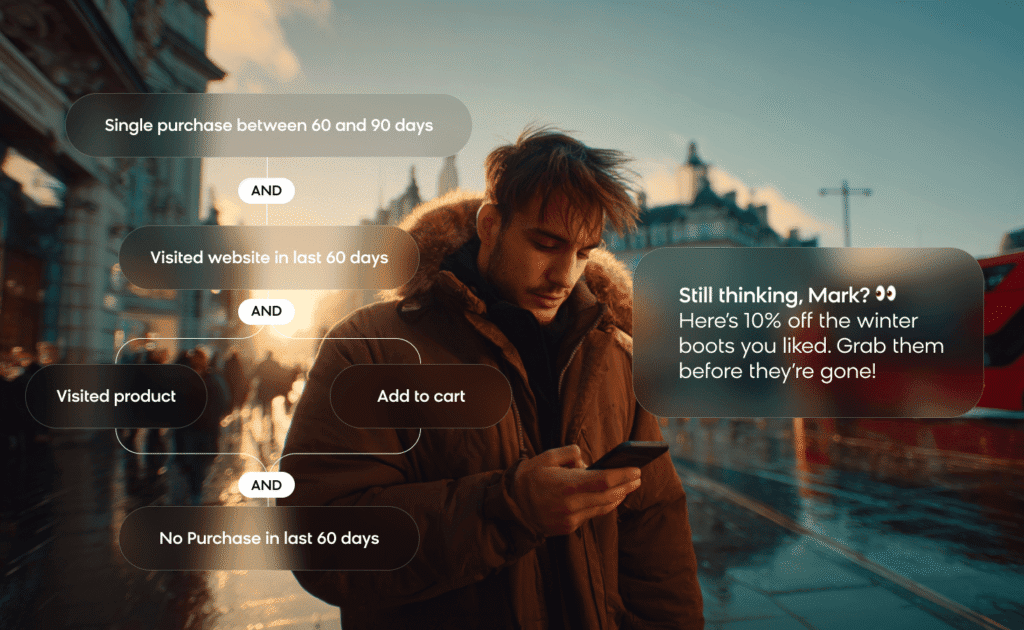Marketing attribution has evolved beyond simple touchpoint tracking. It’s now the strategic process of identifying which customer interactions drive conversions, retention, and revenue across complex digital ecosystems. And yet, many organizations remain trapped by legacy attribution approaches that rely on fragmented data, static reports, and outdated channel-centric tactics.
The AI era demands a fundamental shift in how you approach marketing attribution. Non-linear customer journeys require systems that operate in real time, adapt continuously, and function autonomously rather than merely providing retrospective analysis. The future of marketing attribution isn’t about explaining what happened yesterday — it’s about enabling live, personalized decisions through artificial intelligence.
Read on to learn more about why you should change how you approach marketing attribution, and how AI can enable this in an effective, impactful way.
Why Legacy Attribution Falls Short in Modern Commerce
Traditional marketing attribution models can’t handle the complexity of today’s multi-touch, AI-influenced customer journeys. These outdated systems reveal critical limitations that undermine your marketing effectiveness and strategic decision-making.
Legacy models operate on static, retrospective data collection. First-touch, last-touch, and linear attribution approaches analyze historical interactions but can’t adapt to real-time behavioral changes. This creates significant blind spots during active customer sessions when intervention opportunities are most valuable.
Modern commerce generates fragmented data ecosystems that overwhelm traditional attribution frameworks. Customer interactions span email, social media, SMS, retail locations, chatbots, mobile apps, and emerging channels. Legacy systems struggle to unify these touchpoints into something coherent, resulting in incomplete attribution and misallocated marketing spend.
Most critically, traditional models can’t track AI-driven touchpoints that increasingly influence purchase decisions. Conversational shopping interactions, AI-powered product recommendations, and dynamic content personalization create attribution complexity that rule-based systems simply can’t process effectively.
These micro-signals provide crucial intent indicators that legacy systems overlook entirely. Actions like wishlist additions, scroll depth metrics, time spent viewing specific content, and email engagement patterns reveal purchase intent but remain invisible to traditional attribution models.
Attribution as a Decision Engine, Not Reporting Tool
Real marketing attribution functions as a decision engine rather than a reporting tool. This fundamental shift enables autonomous commerce experiences that adapt to customer behavior without manual intervention.
The evolution from descriptive to prescriptive attribution represents a shift in marketing technology. Instead of generating reports that explain past performance, modern attribution systems drive proactive orchestration of customer experiences based on real-time behavioral analysis.

Machine learning replaces rule-based models that require constant manual updates and maintenance. Advanced attribution systems learn from customer interactions continuously, adjusting their understanding of journey patterns and touchpoint influence without requiring developer help.
Autonomous systems with marketer oversight replace processes that depend entirely on human analysis and decision-making. This approach enables scale and responsiveness that manual attribution management can’t achieve, while maintaining strategic control over key parameters.
Where Legacy Attribution Models Still Add Value
Existing marketing attribution models retain value within modern marketing ecosystems, but their role shifts from primary analysis tools to inputs within more sophisticated AI-driven systems.
| Model | Optimal Use Case | Modern Limitation |
|---|---|---|
| First-touch | Awareness campaign performance | Ignores consideration and conversion efforts |
| Last-touch | Direct conversion tracking | Excludes prior engagement influence |
| Linear | Brand-building exposure measurement | Treats all touchpoints equally without nuance |
| Time-decay | Long sales cycle analysis | Overweights recency while ignoring journey complexity |
| Position-based | Simplified funnel contribution | Breaks down with multi-loop, non-linear customer paths |
| Algorithmic | Campaign efficiency optimization | Requires constant manual updates without AI integration |
These models provide specific analytical value when integrated into comprehensive attribution frameworks rather than serving as standalone solutions. First-touch attribution effectively measures awareness campaign performance, while last-touch attribution tracks direct conversion influence. However, neither approach completely captures the complexity of customer journeys.
The most effective approach combines multiple model types within an interpretable, continuously evolving system. This integration enables you to understand both granular touchpoint performance and comprehensive journey dynamics while maintaining the flexibility to adapt as customer behaviors change.
Turning Attribution Into Action: A Platform Approach
Effective marketing attribution systems drive measurable business outcomes rather than simply explaining customer behavior. This outcome-focused approach transforms attribution from an analytical exercise into a revenue-generation engine.
Real-Time Activation Through Unified Data
Modern platforms unite CDP, journey management, and activation layers within single systems that enable real-time decision-making. AI learns from live customer sessions rather than only historical campaign data, enabling intervention during active engagement opportunities.
Regatta implemented Bloomreach’s autonomous search and autonomous marketing solutions to enable data-driven personalization for all its customers. The AI understands and learns from in-session behavior to personalize every interaction in real time. This level of personalization helped Regatta drive a 4.04% lift in RPV and a 4.82% increase in add-to-cart rate.

Personalization at the Segment-of-One Level
Advanced marketing attribution enables dynamic segmentation that shifts based on real-time behavioral signals rather than static demographic or purchase history data. Modern systems reassess drop-off probability, upsell opportunities, and churn risk during active sessions, enabling personalized interventions at optimal moments.
This segmentation approach delivers substantial results: Lovall achieved 50.85% higher year-over-year CRM revenue growth through live AI journey segmentation powered by real-time attribution analysis. This demonstrates how attribution insights translate directly into revenue improvements through personalized customer experiences.

Consistent Attribution Across Channels and Borders
Comprehensive attribution systems unify customer interactions across web, mobile, email, SMS, point-of-sale, and push notification channels within a single customer profile. This integration ensures journey continuity regardless of channel preference, geographic location, or language requirements.
Bluebell Group was able to take advantage of this with its large and diverse portfolio of brand partners. This complete view of its customers lets the brand scale up personalization — no matter the region or language. And these campaigns have resulted in a significant impact — Bluebell Group can attribute 12-15% of its total ecommerce sales to personalized Electronic Direct Mail (EDM).

Your Attribution Strategy Checklist for 2025
Building an effective marketing attribution strategy requires asking fundamentally different questions that focus on forward-looking optimization rather than backward-looking measurement. Evaluate your attribution capabilities against AI-era requirements rather than traditional reporting standards.
Critical strategic questions to consider:
- Forward vs. backward focus: Do your attribution insights drive proactive optimization or merely explain past performance? Modern systems must enable predictive decision-making rather than retrospective analysis.
- Behavior vs. channel modeling: Does your attribution analyze human behavioral patterns or only channel-level performance metrics? Customer-centric attribution provides more actionable insights than media-centric approaches.
- Autonomous capability: Can your attribution systems make optimization decisions during a marketer’s absence, or do they require constant manual oversight? Scalable attribution operates continuously without human intervention for routine optimizations.
- Unified experience integration: Does your attribution connect customer experience, analytics, and personalization within a single workflow loop? Fragmented systems can’t provide the real-time responsiveness that modern commerce requires.
- Self-improving intelligence: Can your attribution models evolve and improve without manual retuning, or do they require constant analyst maintenance? AI-driven systems adapt to changing customer behaviors automatically.
Making Attribution a Team Sport
Marketing attribution initiatives struggle when they become isolated within data teams or remain too technical for broader organizational adoption. Successful attribution requires cross-functional alignment and accessible presentation of complex analytical insights.
Common organizational barriers include:
Team misalignment regarding journey ownership and KPI responsibility creates conflicting optimization priorities. Marketing, analytics, and customer experience teams often work with different attribution definitions and success metrics, preventing coordinated efforts to improve customer experience.
Technical complexity creates adoption challenges when attribution insights remain inaccessible to non-analytical roles. Complex statistical models and technical jargon prevent stakeholders from understanding and acting on attribution findings.
Data silos between analytics and activation teams prevent attribution insights from influencing customer experience decisions. When attribution analysis remains separate from execution capabilities, insights can’t translate into improved business outcomes.
Effective solutions require:
Defining shared KPIs that align teams around customer lifetime value, customer acquisition cost, and revenue per user metrics. These business-focused measurements create common objectives across organizational functions and enable better coordination.
Marketing attribution must remain explainable and accessible to marketing, merchandising, and customer experience roles beyond data analysts. Clear visualization and business-language explanations enable broader organizational adoption and more effective decision-making.

Training resources should enable cross-functional teams to understand and leverage attribution insights effectively across different organizational roles and technical backgrounds, creating organization-wide attribution literacy that drives better customer experiences.
Level Up Your Marketing Attribution
Marketing attribution now operates as a live decisioning engine rather than a historical reporting dashboard. This evolution transforms attribution from a measurement exercise into a revenue generation system that creates value through real-time customer experience optimization.
To accomplish this, you need a platform like Bloomreach Engagement. Powered by Loomi AI, Bloomreach can autonomously unify customer insights in real time and empower you to take meaningful action immediately. This data-first approach will give you a competitive advantage when it comes to driving customer acquisition, retention, and lifetime value.
Start making your data work for you. Request a personalized demo today to see Bloomreach in action.













